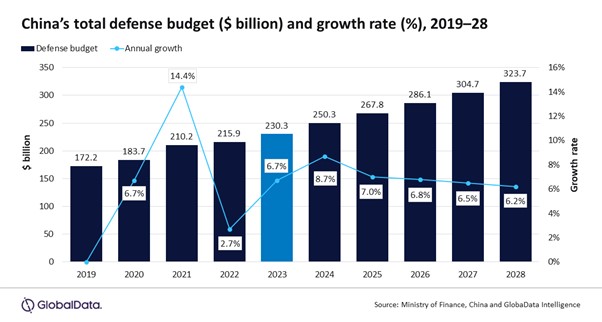Media Release Global Data Newsnetwork, 23 August, 2023: The growing US assistance to Taiwan, escalating territorial disputes with its neighbours in the South China Sea, and security alliances like QUAD and AUKUS formed by regional rivals have become a cause of concern for China. In line with the modernization plan of the People’s Liberation Army (PLA), the country’s defense expenditure is forecast to grow significantly and record a robust compound annual growth rate (CAGR) of 6.6% with a cumulative spending of $1.4 trillion over the period 2024-28, according to GlobalData, a leading data and analytics company.

GlobalData’s latest report, “China’s Defense Market Size and Trends, Budget Allocation, Regulations, Key Acquisitions, Competitive Landscape and Forecast, 2023-28,” reveals that the country’s defense budget grew from $172.2 billion in 2019 to $230.3 billion in 2023. The increase in the defense budget is primarily due to a slew of ongoing and planned procurement programs, which aim to modernize the country’s current defense inventory.
Akash Pratim Debbarma, Aerospace & Defense Analyst at GlobalData, comments: “The estimated significant financial commitment of $1.4 trillion is a clear indication of China’s strategic vision. This modernization initiative isn’t just about numbers, it is about a calculated investment in innovation, readiness, and a global role that aligns with China’s rising influence.”
In the pursuit of building a strong blue water navy and developing a credible nuclear deterrent, China is in the process of procuring its fourth Aircraft Carrier, Tang-class Nuclear-Powered Ballistic Missile Submarine (SSBN), Type 054A Frigates and Renhai-class (Type 055) Destroyers. These major ongoing procurement programs, once completed, will certainly reshape regional and global security dynamics.
Debbarma adds: “China’s naval evolution stands as a testament to its strategic foresight and determination to enforce its interests in key regions like the East China Sea, the South China Sea and the Yellow Sea. A noteworthy transformation is underway as the Chinese Navy shifts from its traditional coastal defense role to a formidable blue water fighting force. This metamorphosis, driven by a vision of comprehensive maritime prowess, underscores China’s intent to reinforce itself as a major stakeholder in calling shots and determining global orders.”
In response to restrictions and embargoes by the US and EU on the transfer of foreign defense technology to the country, China has effectively transformed these constraints into opportunities by nurturing a self-reliant defense equipment manufacturing industry.
Debbarma concludes: “The strategic pivot was propelled by China’s leverage of non-defense technology for defense applications, bridging the divide between civil and military industries. This innovation-driven approach not only revived a once struggling defense sector but also elevated China’s capabilities to engineer a wide spectrum of cutting-edge defense systems, from fighters and missiles to aircraft carriers and submarines.”
ENDS




